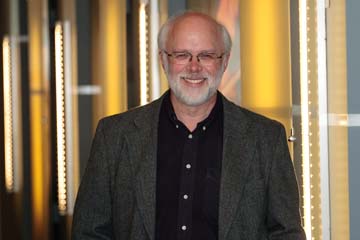How One Designer Showed an Architect the Power of Image Size
 Audiovisual consultant and project manager Thom Mullins shines a light on AVIXA’s display image size standard.
Audiovisual consultant and project manager Thom Mullins shines a light on AVIXA’s display image size standard.
An AVIXA member since the late 1980s, audiovisual consultant and project manager Thom Mullins, CTS, has had his finger in the standards pie since way back. Before there was even a Standards program, he participated in several standards-related work groups and was a key contributor to standards development. Last year he joined the Standards Steering Committee, taking the reins as the Committee Chair in 2017.
Having standards in place not only brings credibility to the work that’s undertaken, according to Mullins, but it also aligns the AV industry with the IT world, where standards are the norm. “Standards provide evidence-based design,” he says, “and they help move the industry away from subjective direction.”
Most recently, he’s been utilizing ANSI/INFOCOMM V202.01:2016, the Display Image Size for 2D Content in Audiovisual Systems (DISCAS) standard in his work as leader of the AV design group for Affiliated Engineers, Inc., a multi-discipline technical consulting firm with 15 offices worldwide. Mullins is based at AEI’s Seattle office.
“One of the issues that we continually run into with clients is how big the image should be. Everyone comes to the table with a different idea of what that’s supposed to be,” he explains. “In the past, it was not necessarily based on science or on current research that had been done. People still refer back to the 4-6-8 rule or the 1:150 rule and base their decisions on things they think worked on an earlier project. I’ve walked into a room a number of times after an installation and the client thinks the image is too small, but their ceiling is low and we don’t have a choice. So we can use this as a tool. To be able to go back to a standard like DISCAS allows us to ask questions like: How important is detail? What are the images they’ll be watching? We can refer to the standard and make a recommendation for the size of the image, and then we can get into details like resolution and what the client can afford. We can say to our client, ‘based on the image and the standard, this is our recommendation to you.’ AVIXA has created a calculator to help illustrate how these details can be determined.”
When juggling several different groups’ viewpoints, such as those of the client, the project management, and the architect, Mullins refers to the standard as a “nice sword to have in a battle.” On a recent project in Seattle, a disagreement over the size of the display was easily resolved by referring to the new standard.
“Part of that project was a presentation auditorium for lectures and distance learning; it was to be a signature space for the institute to showcase what they were doing. In the first meeting with the architect, it was clear that his calculations were based on a smaller image than we were recommending.
“I was able to go back and say, based on the standard and the communication with the client, we think the image should be a minimum size of this — which was bigger than the architect and the client had imagined. But it was important for people in the back row to be able to see the medical detail in the image, and therefore, how big it should be. At that point, the conversation ended and the architect agreed that that was the size we should go for and the client could easily see the benefit, even with the bigger price tag.”
In that same space, there was also a discrepancy over the location of whiteboards on the wall beneath the image. Viewers in the front rows would be forced to look up at the image at awkward and painful angles. Mullins and his team were able to model the space with a variety of different images that demonstrated the detail a person sitting in different places in the room would see, and how those images would appear to them, in accordance with the standard’s guidance on the closest viewing distance.
“The architect relayed that the client wanted whiteboards at the lower level of the audience on the stage, but after looking at the modeling and the image sizing, we were able to say, you really don’t want to do that because people will have to crane their necks to see. The architect acquiesced and lowered the image so that the people in the front rows wouldn’t be looking up at an uncomfortable angle.”




